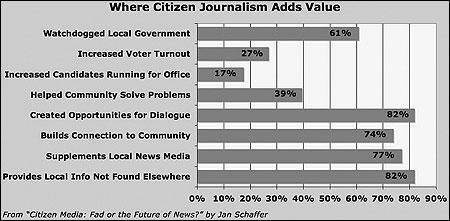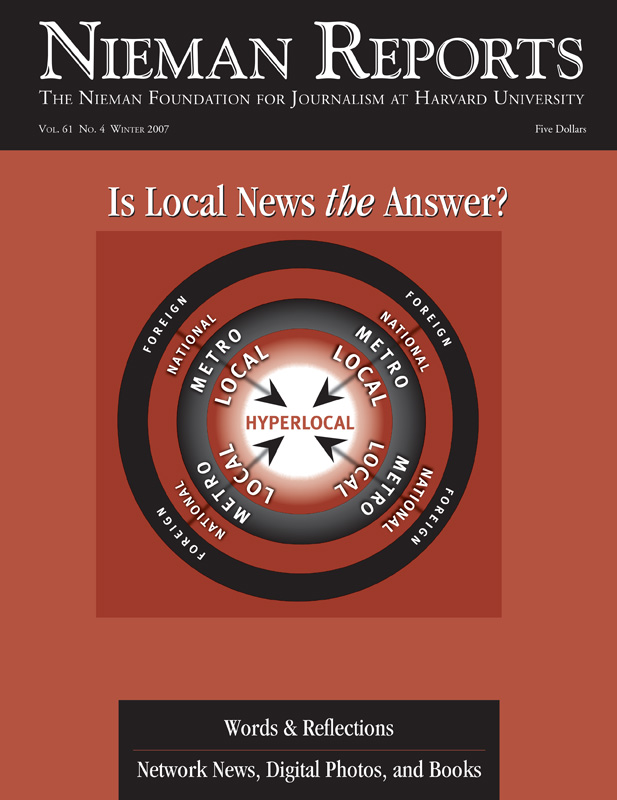RELATED WEB LINK
Dutton Country Courier
—DuttonCC.org In rural Dutton, Montana, 80 people showed up last fall, wooed by a notion of starting a local news site for this newspaperless town of 375 people. Months later, the community celebrated the launch of the Dutton Country Courier. In Chappaqua, New York, three long-time community volunteers decided their community needed a weekly online newspaper. So in early October, they launched NewCastleNOW.org: News & Opinion Weekly. Meanwhile, in Moscow, Idaho, low-power KRFP-FM radio, just two years after it began airing a citizen-produced nightly newscast on radiofreemoscow.org, is applying for a noncommercial radio license.
All three of these citizen media projects were fueled in small part by microgrants from the J-Lab/Knight Foundation New Voices program, but they are being sustained in much larger part by the passion, vision and hard work of their creators. From girls podcasting in the Lower East Side of Manhattan, to environmental journalists creating a wiki about the Great Lakes, to journalism students scooping Chicago news outlets, in two years some 30 New Voices start-ups have joined scores of other hyperlocal ventures in committing what some refer to as “random acts of journalism” by “citizen journalists.”

It is here—on these hyperlocal sites—that systemic conventions of inverted pyramids and “balanced” stories are out of sync with information conveyed amid a keen caring about community. “These are not multiple-source stories,” said veteran journalist Suzanne McBride of the items on CreatingCommunityConnections.org, which she cofounded in Chicago. “It took me a while to say that’s okay; it’s not libeling anyone. I had to change my thinking about that,” she told a Citizens Media Summit at the The Associated Press Managing Editors’ conference in October.
Nonjournalists sharing photos and videos of breaking news events—from the London bombings to the South Asia tsunami, from the violence of Burma’s protests to Benazir Bhutto’s return to Pakistan—garners media attention, yet what’s happening on emerging hyperlocal news opens a window to observe what is happening in journalism today. In communities with little news coverage, people are using the Web to restore a sense of place. Behind these hyperlocal efforts is a desire to get local citizenry engaged in issues affecting their lives—in essence, to create a civic media that at the same time constructs a new architecture of participation in their towns.
RELATED WEB LINK
“Citizen Media: Fad or the Future of News?”
– kcnn.org/Learning curves at many of these Web sites are still high, but those of us who closely observe and do research about these efforts already know a lot. Earlier this year, J-Lab released one of the first reports on the rise of local news sites based on user-generated content (UGC). The research, “Citizen Media: Fad or the Future of News?,” reported on survey responses from 191 citizen media participants and about in-depth interviews with those involved with 31 Web sites.
Here are some of the key findings:
- Citizen media is emerging as a form of “bridge media,” linking opportunities to share and create news and information with opportunities to get involved in civic life.
- No one size fits all; there are many models. Sites have been started by former journalists, seeking to be the I.F. Stone of their towns, and by friends of the public library seeking to construct a local news entity.
- Instead of being comprehensive sources of news, sites are formed as fusions of news and schmooze. Stories unravel over a series of postings and people, contrary to traditional journalistic conventions, “cover” the topics they care most about and know something about.
- Half the respondents said their sites don’t need to make money to continue. Costs can be as low as $13 a month for server space, and volunteers provide most of the labor. But site founders concede it would be nice to be able to pay a little to contributors.
- Most citizen sites don’t use traditional metrics—unique visitors, page views, or revenues—to measure success. Even so, 73 percent assessed their efforts to be “successful.”
- Success is often defined as impact on the community. Included as evidence of their effectiveness are such accomplishments as increasing voter turnout in elections and attendance at town meetings, helping communities to solve problems, and being a watchdog on local government. [See accompanying graph above.]
- There is a high degree of optimism that citizen news and information sites are here to stay. But founders note that attracting more contributors and some operating support continue to be major challenges.
RELATED ARTICLES
“Going Hyperlocal at Chicago Tribune”
– Kyle Leonard
“Childhood Memories Kindle Hyperlocal Strategies”
– Rob Curley With the rise of so many independent local news sites, traditional news outlets are now trying to enter this space with their own iterations of UGC
sites, such as the Chicago Tribune’s TribLocal.com and The Washington Post’s LoudounExtra. For the most part, news organizations are starting from scratch in developing their hyperlocal news sites rather than partnering with existing ones. It remains to be seen whether the sites affiliated with news outlets will achieve the passion and caring for community exhibited by the independent start-ups.
Some citizen media site operators think such competition is senseless. “We are plankton,” says Christopher Grotke, who cofounded iBrattleboro.com in Vermont. He would like to see news organizations feeding off his site—and others like it—rather than trying to replicate what it already does.
RELATED ARTICLE
“Tips About Starting a Hyperlocal Web Site”
– Jan Schaffer It remains an unanswered question as to whether sustainable business models will emerge out of the numerous citizen media now on the Web. Perhaps activity such as this will be a venue for a new type of community volunteerism, something baby boomers do after they finish coaching their kids’ soccer teams. But it’s increasingly clear that sites like these are transforming how local journalism is practiced and even what it is and what it can do.
From his perch at MyMissourian.com, Clyde Bentley believes that “traditional journalism plus citizen journalism equals 21st century journalism.” I agree.
Jan Schaffer is executive director of J-Lab: The Institute for Interactive Journalism at the University of Maryland. E-mail news@j-lab.org to get a copy of “Citizen Media: Fad or the Future of News?.”


